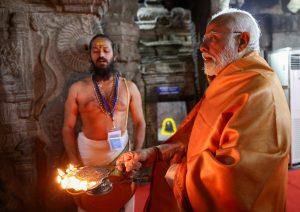Next week, a few days before India’s Republic Day, Prime Minister Narendra Modi will inaugurate a grand temple in the town of Ayodhya, dedicated to the widely revered Hindu deity, Lord Ram.
The temple itself has long been the subject of controversy and legal dispute, spanning decades of both violence and peaceful protest. That controversy has refused to die down in the run-up to its consecration next week. In a surprising development, four top Hindu spiritual leaders announced that they would not be attending the ceremony. One of them argued that the ceremony would be a violation of Hindu scriptures because it hasn’t been fully built yet.
Yet, in a very different sense, the timing of the ceremony — shortly before India marks its Republic Day — is significant in marking India’s ongoing transition to what some have called a “Second Republic.”
On January 26, India will mark 74 years since the adoption of its constitution. Set against the backdrop of a bloody partition, which resulted in the creation of a Muslim state in Pakistan, India’s Constituent Assembly debated for years over the question of religion in state policy and public life. The result was a unique, if sometimes contradictory, conception of secularism.
In an effort to hold together a deeply religious and yet dizzyingly diverse nation, India’s founding fathers decided that the government and its representatives would treat all religions equally while simultaneously supporting the religious activities of private citizens. That included various schemes and subsidies for religious pilgrimages and a long list of national holidays honoring the festivals of every major religion. It also included an active repudiation of overt state patronage for any specific religion.
This compromise inevitably left some sections unhappy. Hindu nationalist ideologues eyed Muslims with some envy over the creation of Pakistan and were furious at being denied a Hindu state of their own. They also questioned why Muslims should enjoy state subsidies for annual pilgrimages to Mecca — also called the hajj. They chafed at special constitutional provisions for religious institutions run by minorities, which ran counter to government control over Hindu temples.
Nonetheless, India’s messy and contentious version of secularism managed to create a national identity that proved inclusive enough to save it from the widespread sectarian tensions that consumed Pakistan next door. India’s first Prime Minister Jawaharlal Nehru handily won as many as three national elections, despite his rejection of Hindu deities — perhaps helping to prove that India was not necessarily fated to become a Hindu state even if its population was largely Hindu. Communal violence was largely contained and sporadic, until at least the 1980s.
In his decade as India’s prime minister, Modi has since sought to reverse many of these conventions and provide state patronage to the Hindu religious identity. This campaign was originally predicated on the belief that India’s secularism was unfairly skewed in favor of its religious minorities. In 2018, Modi abolished the hajj subsidy, even as he introduced other schemes to support Hindu pilgrims traversing across India. Modi’s Bharatiya Janata Party (BJP) has also steadily chipped away at Muslim representation in national politics, and since 2022, it has had no Muslim member of parliament — in a country where about 200 million people belong to that community.
Yet, as significant as these changes are, it is the opening of the Ayodhya temple that may prove most consequential as a marker of India’s transition away from a secular republic. That is more due to Modi’s use of the office of the prime minister than due to the temple itself.
For decades, Hindu nationalists have campaigned to free temples from state control, arguing that this is a violation of secularism and that it was unfair by comparison that religious minorities were permitted special rights in running their own institutions. But under Modi, India has seen no sweeping concession to this demand. Instead, especially in Ayodhya, Modi and the state machinery have loomed large over ceremonies that are ordinarily deemed religious.
In the run-up to next week’s ceremony, for instance, reports said that Modi had issued a directive to politicians to visit local temples. Meanwhile, some religious leaders complained that they were not consulted in drawing up the procedures of the ceremony. Instead, Modi will perform a leading religious role at the ceremony himself.
The use of elected political office to head Hindu ceremonies is largely unprecedented in India’s history as a secular republic, and it will have several groundbreaking implications. Much like the King of Saudi Arabia, who is styled the “Custodian of the Two Holy Mosques,” Modi has now set a precedent for India’s prime minister to perform religious functions — thereby effectively rendering non-Hindus unelectable for that position. Modi’s directive to politicians, asking them to visit Hindu temples, would also have the same effect in disenfranchising non-Hindu politicians.
For years, despite numbering over 200 million — or as large as the population of Brazil — India’s religious minorities have been retreating from public and political life. But India now seems to have cemented a new political paradigm, disjointed from its journey thus far as a secular republic.

































